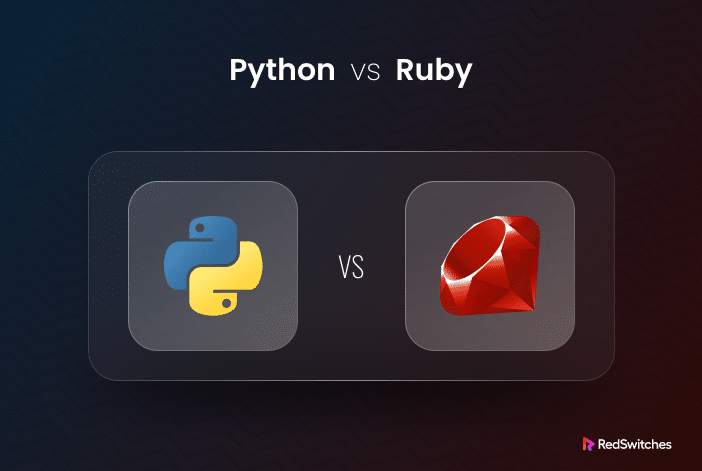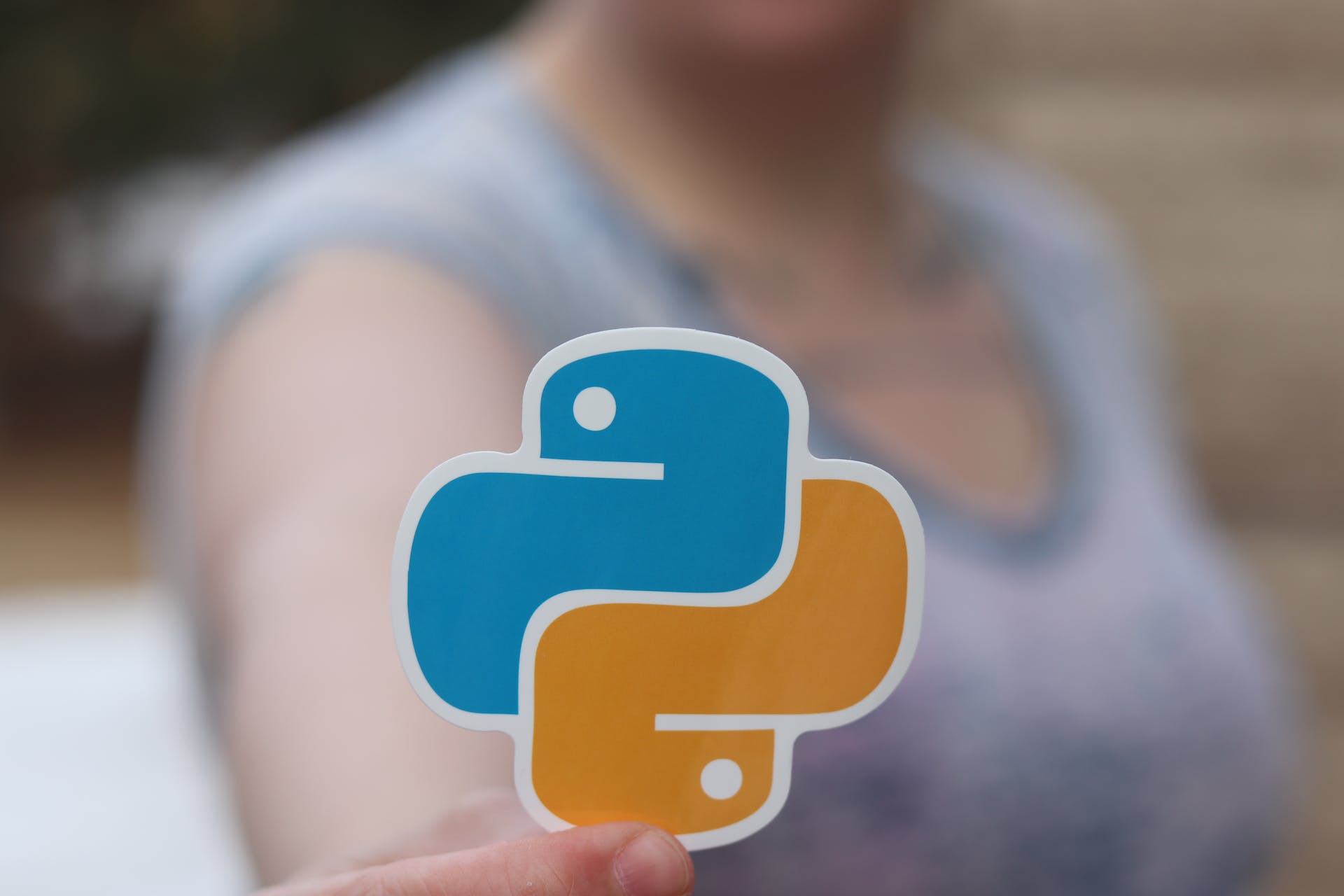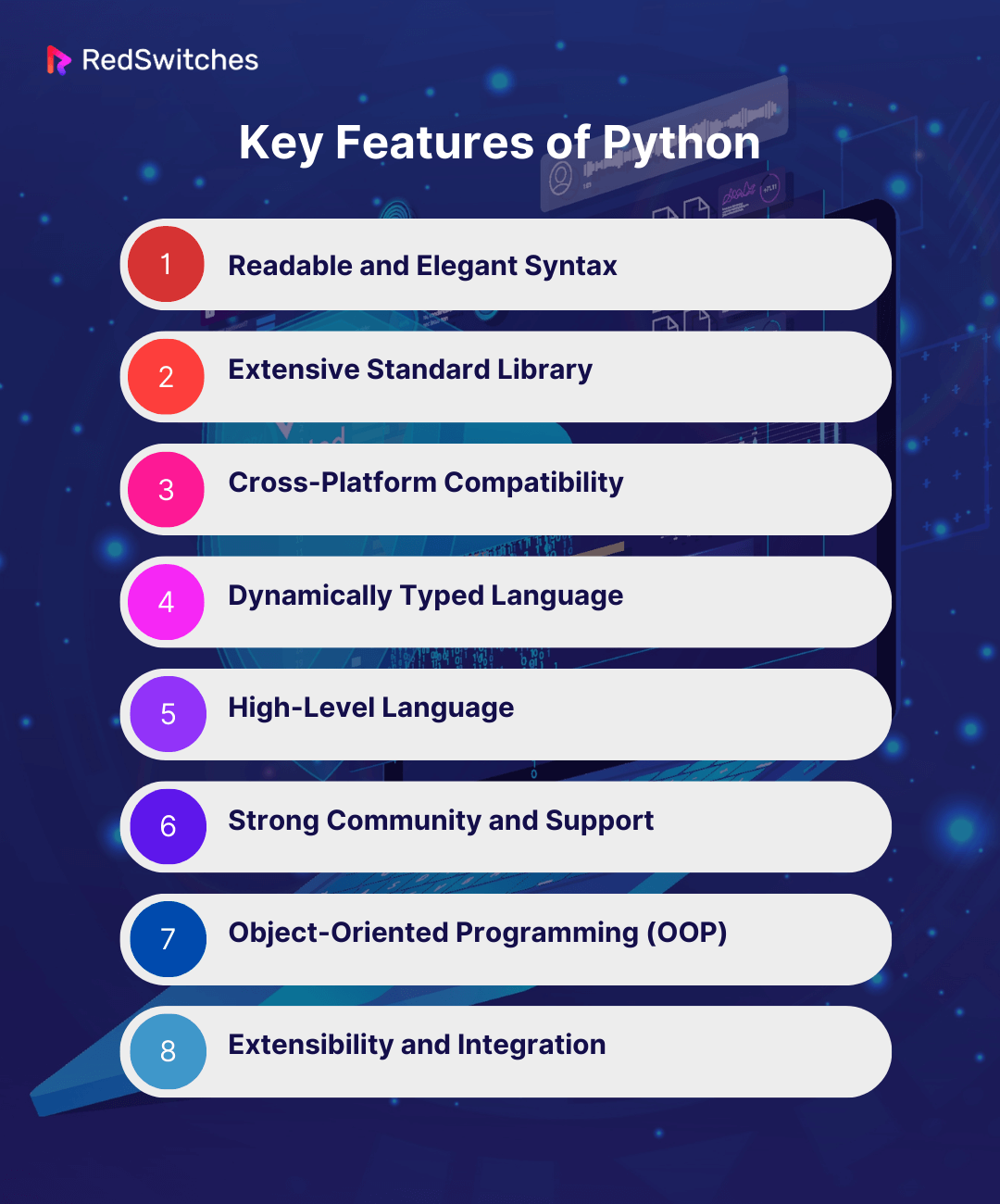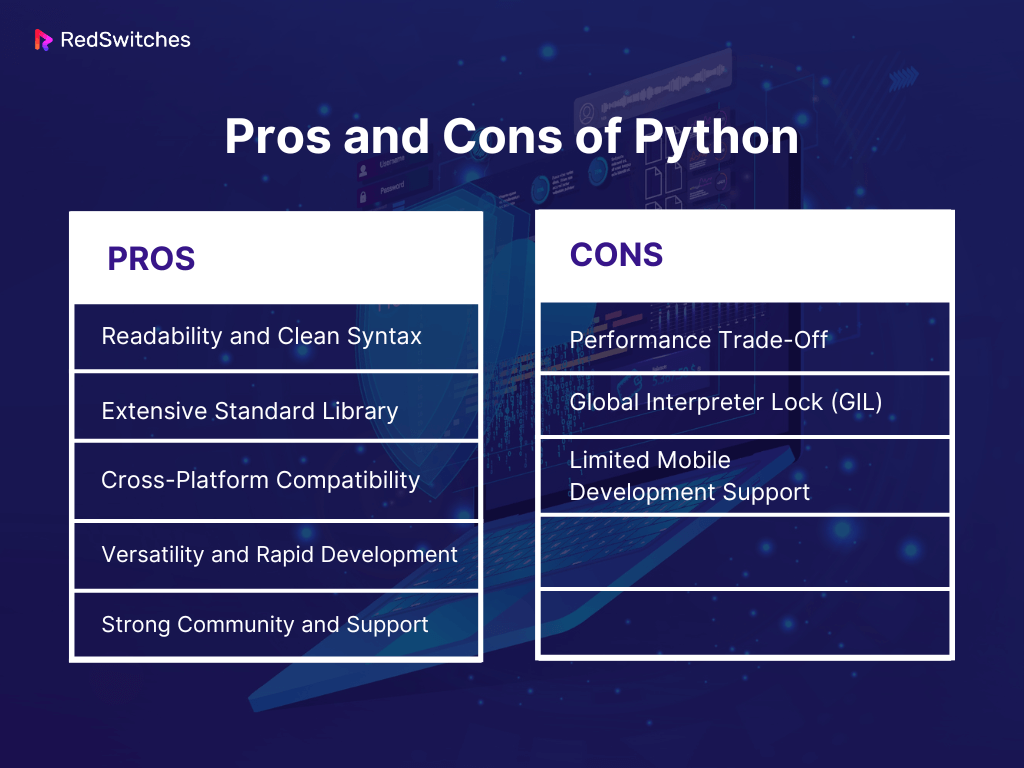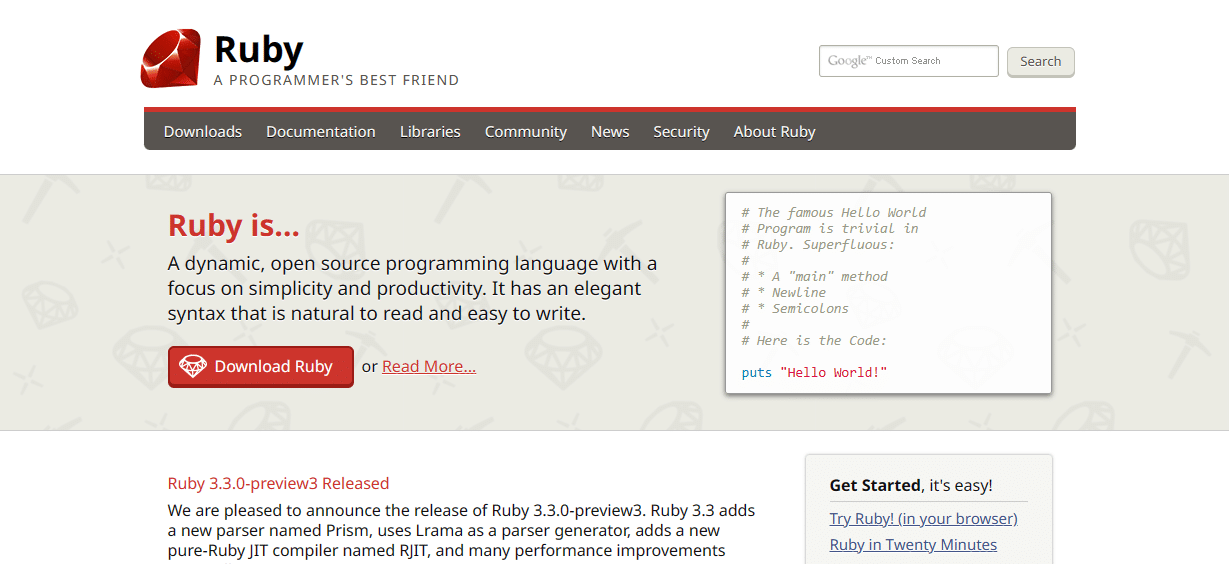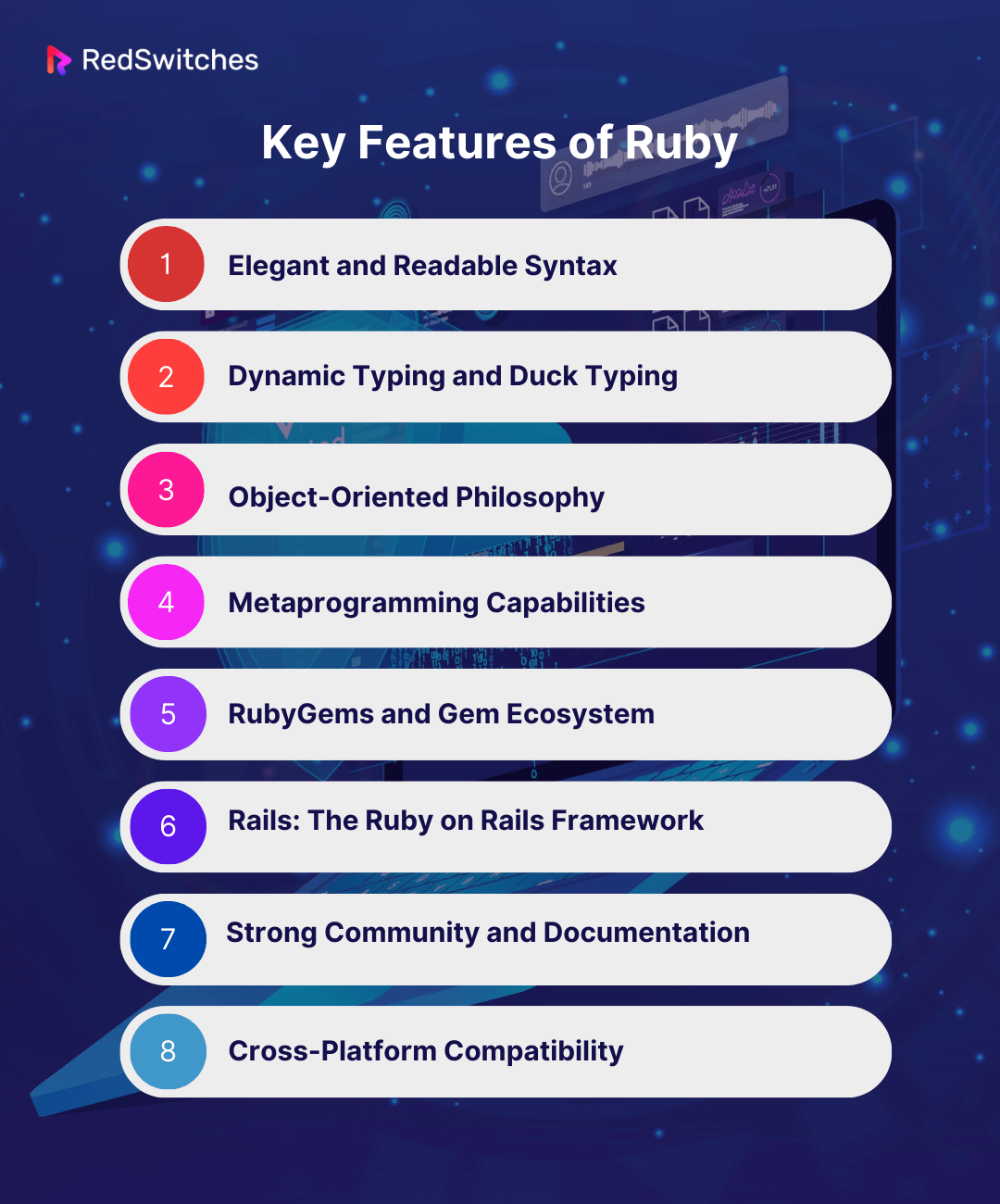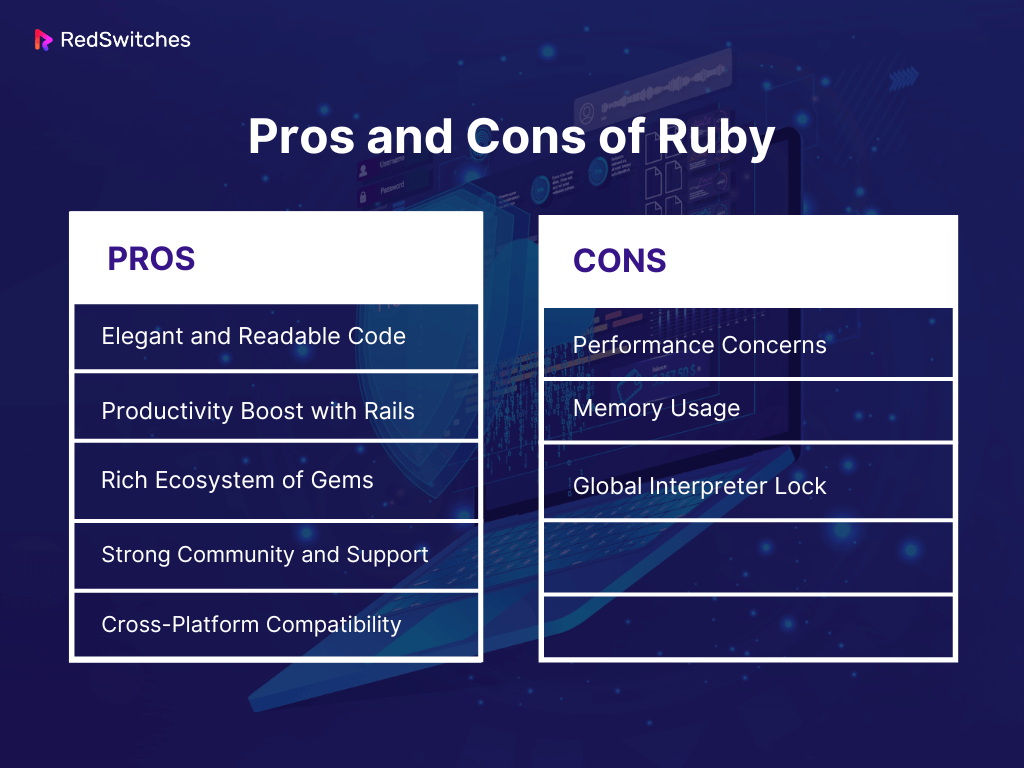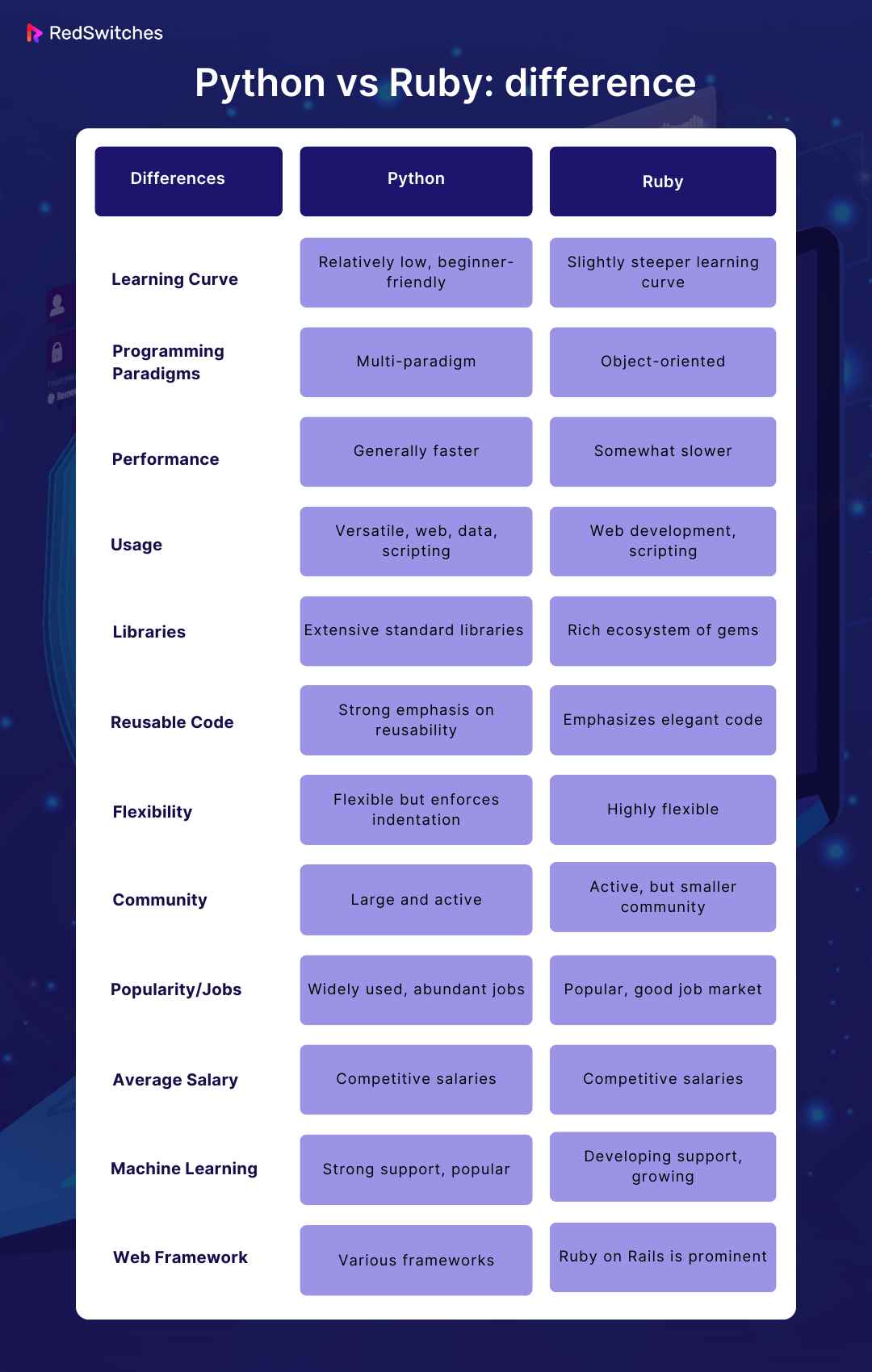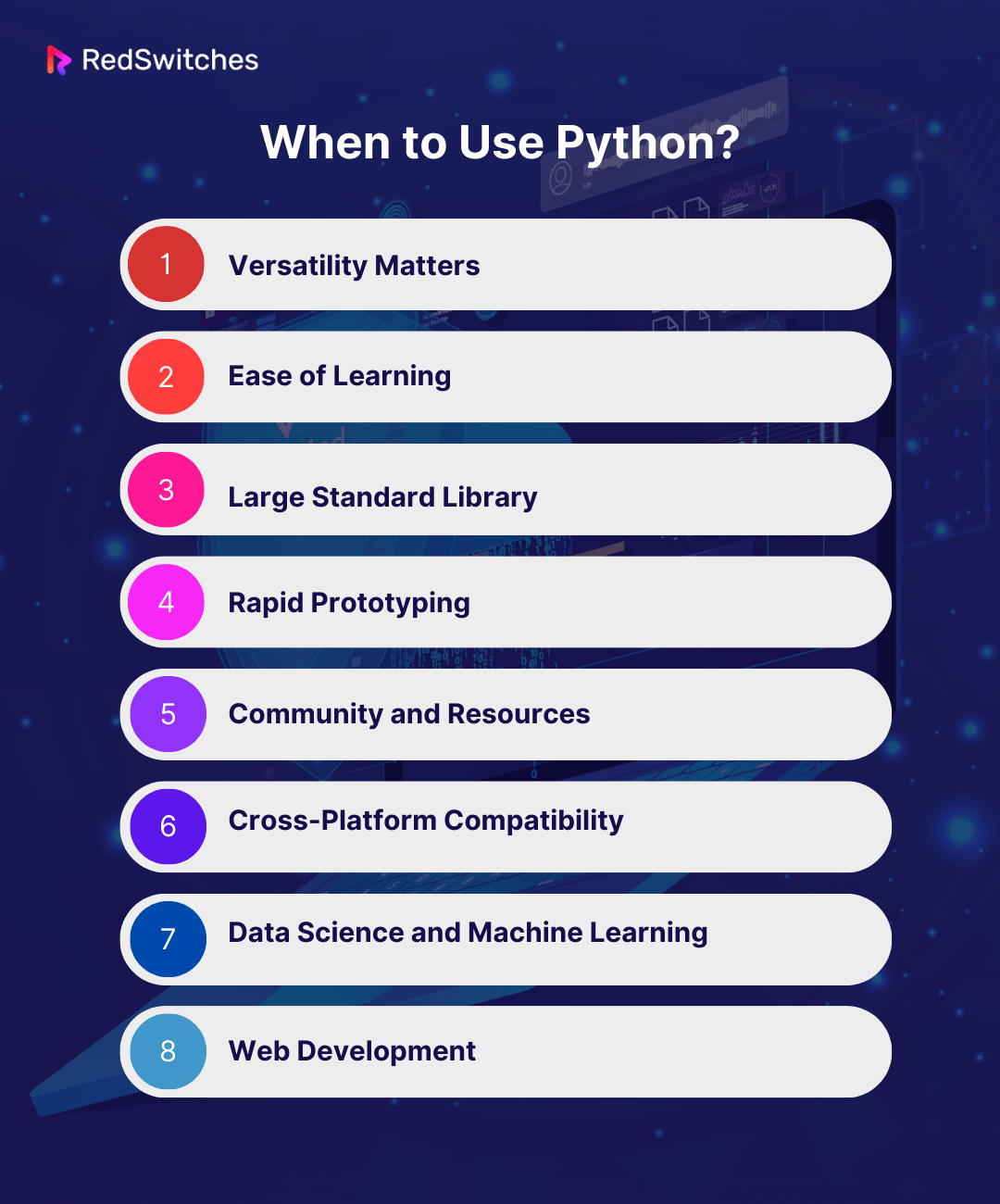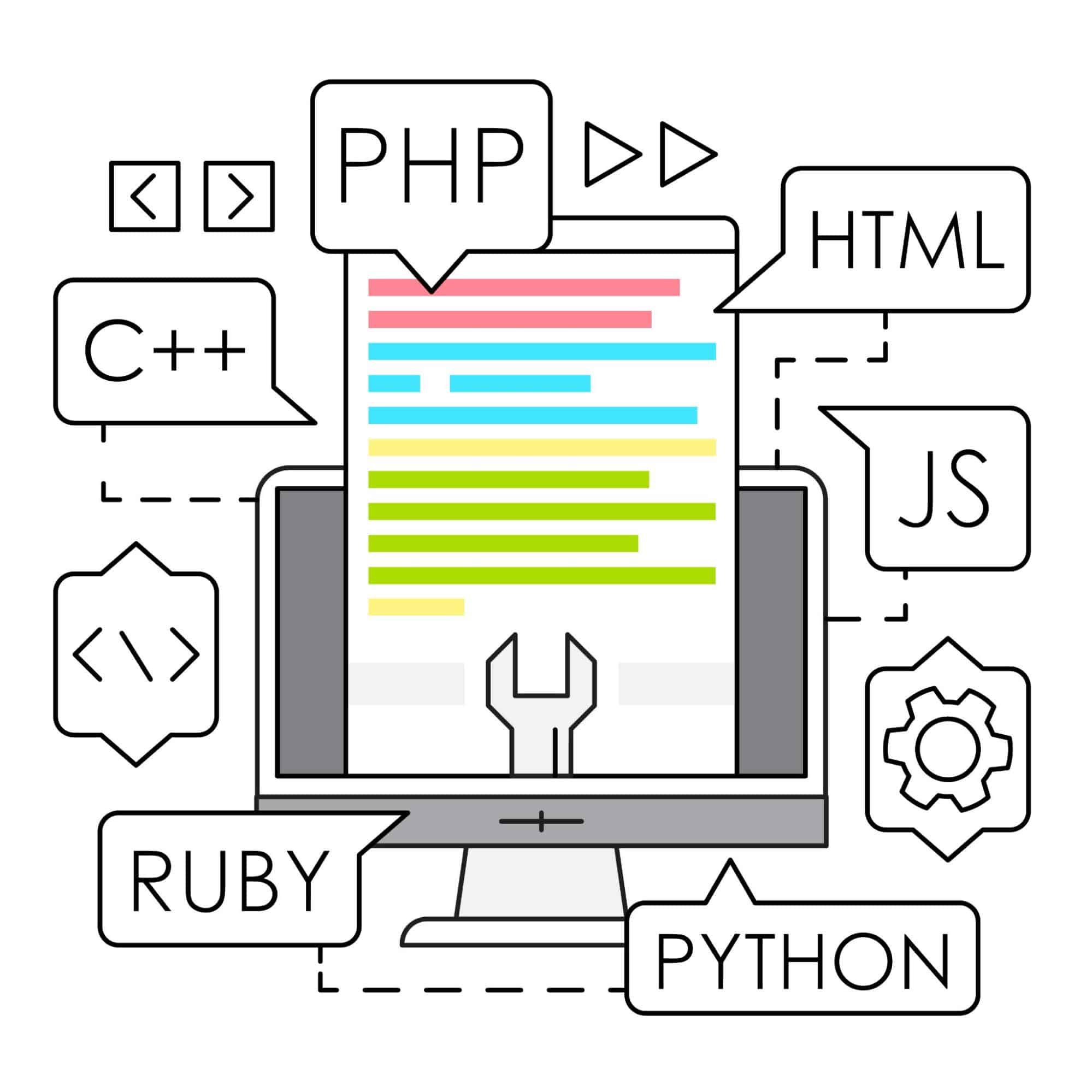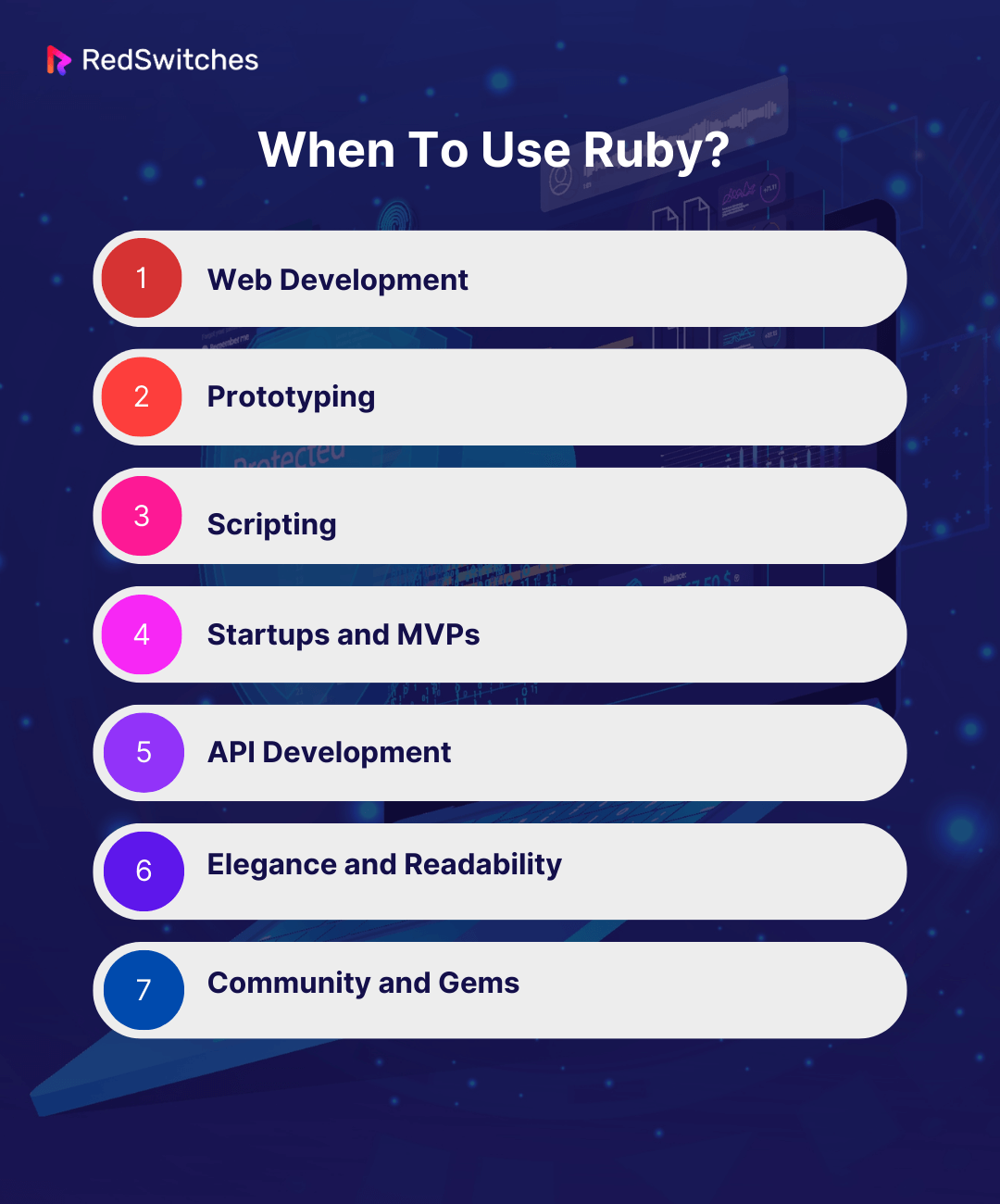Python and Ruby are two prominent programming languages with distinctive strengths and weaknesses. According to Statista’s list of the 2023 most popular programming languages, Python ranks third, with 49.28 respondents claiming they use it, whereas Ruby ranks 16th, with 6.23 respondents.
Although there is a significant difference in the number of individuals who use Python and Ruby, it is essential to understand that both programming languages have their own use cases.
Whether you’re a seasoned developer looking to deepen your expertise or a newcomer wondering which language to learn, this comprehensive comparison between Python vs Ruby will guide you through their key features, pros and cons, and differences.
Table of Contents
- What is Python?
- What is Ruby?
- Key Differences Between Ruby vs Python
- When to Use Python?
- When To Use Ruby?
- Conclusion – Python vs Ruby
- FAQs
What is Python?
Credits: Pexels
Python is a high-level interpreted programming language developed in the 1980s. It is known for its simplicity and readability. Python has gained immense popularity in software development. Its design philosophy focuses on code readability, making it ideal for all levels of programmers.
Python’s syntax is clear and concise, featuring indentation-based block structures that improve code clarity. Its extensive standard library covers multiple tasks, including web development, data analysis, scientific computing, and AI.
Python’s versatility allows it to be used in various domains, including web development, data science, and automation. Its strong community support, abundant documentation, and third-party libraries and frameworks make it a top choice for developers worldwide.
Do you struggle to find the length of a list in Python? Read our informative blog ‘How to Find the Length of a List in Python: Three Easy Methods and Tips’ for a solution.’
Key Features of Python
1. Readable and Elegant Syntax
One of Python’s standout features is its clean and concise syntax. The language emphasizes readability, with code that closely resembles plain English. Indentation is used for code blocks, eliminating the need for braces or semicolons. This readability makes Python code easy to write and improves collaboration and maintenance, making it an excellent choice for novices and experienced developers.
2. Extensive Standard Library
Python’s rich and extensive standard library covers various tasks, from handling data structures to networking and web development. These prebuilt modules and packages save developers time and effort, allowing them to leverage powerful tools without reinventing the wheel. Whether you’re parsing XML, working with regular expressions, or implementing socket programming, Python’s standard library has you covered.
3. Cross-Platform Compatibility
Python is platform-independent, which means code written in Python can run smoothly on several operating systems, including macOS, Windows, and Linux. This cross-platform compatibility simplifies application deployment and makes Python the go-to choice for projects that must reach a large audience.
4. Dynamically Typed Language
Python is dynamically typed, so you don’t need to declare variable types explicitly. This flexibility allows developers to write code more quickly and makes Python well-suited for swift application development and prototyping.
5. High-Level Language
Python is considered a high-level language, abstracting complex low-level operations, including memory management, away from developers. This abstraction makes Python code more concise and easier to maintain, freeing developers and empowering them to focus on solving problems instead of managing system resources.
6. Strong Community and Support
Python’s vibrant and active community of developers has produced various resources, documentation, and third-party libraries. Whether you’re troubleshooting an issue, seeking guidance, or looking for a specialized library, Python’s community support is readily available.
7. Object-Oriented Programming (OOP)
Python is a versatile language that supports multiple programming paradigms, including object-oriented programming (OOP). OOP allows developers to structure code around objects. This makes it easier to model real-world entities and create reusable, modular code.
8. Extensibility and Integration
Python can be easily integrated with other programming languages like C, C++, and Java, allowing developers to leverage existing codebases and libraries smoothly. This extensibility makes Python a valuable tool for building hybrid applications and interfacing with systems written in other languages.
Credits: Unsplash
Pros and Cons of Python
Pros
1. Readability and Clean Syntax
One of Python’s most celebrated features is its clean and elegant syntax. The language was designed with readability in mind, favoring human-friendly code that closely resembles plain English. Instead of cumbersome braces or semicolons, Python’s use of indentation for code blocks makes it incredibly easy to read and write. This readability aids developers in writing code and simplifies collaboration and debugging, ultimately reducing development time.
2. Extensive Standard Library
Python’s rich and extensive standard library often called the batteries included feature, covers various functionalities, from data manipulation and file handling to networking and web development. These pre-built modules and packages save developers significant time and effort by offering powerful tools to accomplish various tasks.
3. Cross-Platform Compatibility
Python is a cross-platform language, meaning that code written in Python can run smoothly on various operating systems. This cross-compatibility simplifies the deployment of Python applications and ensures that your software can reach a significant audience without modification. This feature is precious when developing software for diverse environments.
4. Versatility and Rapid Development
Python is a dynamically typed language, so you don’t need to declare variable types. This flexibility allows developers to write code quickly, making Python an ideal choice for rapid application development and prototyping. Python’s high-level abstractions also simplify complex tasks.
5. Strong Community and Support
Python boasts a highly active community of developers. This is a significant advantage for anyone learning or working with the language. The community provides extensive documentation, forums, and online resources, making finding solutions to problems or seeking guidance easy. Python’s popularity has led to many third-party libraries and frameworks catering to various application domains, further enhancing its versatility.
Cons
1. Performance Trade-Off
Python is an interpreted language that tends to be slower than compiled languages like C++ or Java. This performance trade-off can be significant for applications like real-time systems or high-performance computing tasks. While Python offers various optimization techniques and can integrate with faster languages, it may not be the best choice for resource-intensive applications.
2. Global Interpreter Lock (GIL)
Python’s Global Interpreter Lock (GIL) can significantly limit multi-threaded applications. The GIL allows only one thread to execute Python code at a time, hindering the full utilization of multi-core processors. While there are workarounds like multiprocessing, this limitation can be a barrier for developers looking to leverage the potential of multi-threading fully.
3. Limited Mobile Development Support
Python isn’t the go-to language for mobile app development. While frameworks like Kivy and BeeWare enable mobile app development with Python, the ecosystem and performance in this domain are less robust than those of languages like Java (Android) or Swift (iOS). If mobile development is a primary focus, you may want to consider other options.
Also Read: How to Upgrade Python to Version 3.9 On Windows, macOS, And Linux.
What is Ruby?
Credits: Ruby Website
Ruby is a one-of-a-kind, high-level programming language known for its simplicity and productivity. Yukihiro Matsumoto curated it in the mid-1990s. The programming language strongly emphasizes readability and elegant code, making it a favorite among programmers for web and software development.
Ruby is often called ‘developer-friendly’ due to its clean and friendly syntax. This enables programmers to write code that resembles natural language, improving collaboration and maintainability.
Ruby’s versatility, object-oriented nature, and extensive ecosystem of libraries and frameworks have made it a valuable tool for building web applications, scripting, and various software projects. Its popularity continues to thrive, driven by its commitment to programmer happiness and active and supportive community.
Key Features of Ruby
1. Elegant and Readable Syntax
Ruby’s syntax is renowned for its elegance and readability. Matz designed Ruby with the principle that code should be easy to write and understand. Its clean and concise syntax minimizes unnecessary punctuation, making code resemble natural language. The use of blocks and closures adds to its expressiveness. This allows developers to write elegant and highly maintainable code.
2. Dynamic Typing and Duck Typing
Ruby is a dynamically typed language, meaning variables have no fixed data types. This flexibility allows developers to write code without specifying variable types, making Ruby well-suited for rapid application development. Ruby employs duck typing, focusing on an object’s behavior instead of its class, encouraging more flexible and reusable code.
3. Object-Oriented Philosophy
Ruby is a pure object-oriented programming (OOP) language. In Ruby, everything is an object, including numbers, strings, and even classes. This approach fosters a consistent and intuitive programming model where developers interact with objects and their methods, promoting modular and maintainable code.
4. Metaprogramming Capabilities
Ruby’s metaprogramming capabilities enable developers to write code that can modify its own structure and behavior during runtime. This feature empowers developers to create dynamic and flexible applications. Ruby’s metaprogramming is exemplified through its ability to define new methods, modify classes, and implement domain-specific languages (DSLs) effortlessly.
5. RubyGems and Gem Ecosystem
RubyGems is Ruby’s package manager, providing a vast repository of libraries and frameworks known as ‘gems.’ This extensive ecosystem of gems covers various functionalities, from web development and database integration to testing and scientific computing. RubyGems simplifies code reuse and accelerates development by allowing developers to integrate third-party code into their projects efficiently.
6. Rails: The Ruby on Rails Framework
Ruby on Rails, often referred to as Rails, is a robust web application framework built on top of Ruby. Rails follows convention over configuration (CoC) and do-not-repeat-yourself (DRY) principles, enabling developers to create web applications with minimal boilerplate code rapidly. Its modular architecture and extensive libraries make it a top choice for building web applications efficiently.
7. Strong Community and Documentation
Ruby features an ever-growing community, contributing to its continued growth and improvement. Developers benefit from a wealth of documentation, tutorials, and forums, making seeking help and sharing knowledge easy. The community’s collaborative spirit has resulted in the development of numerous open-source projects and gems that enrich the Ruby ecosystem.
8. Cross-Platform Compatibility
Ruby is a cross-platform language running on various operating systems. This portability allows developers to write code once and deploy it easily across different platforms, making Ruby a versatile choice for projects targeting diverse environments.
Also Read: How to Install Ruby on Ubuntu 22.04
Pros and Cons of Ruby
Pros
1. Elegant and Readable Code
One of Ruby’s most notable strengths is its elegant and highly readable code. Ruby’s syntax is designed to resemble natural language, making it expressive and concise. This focus on readability encourages developers to write clean and understandable code, reducing the potential for errors and smoothing collaboration among team members.
2. Productivity Boost with Rails
As stated above, Ruby on Rails is a web application framework built on top of Ruby. It’s a game-changer for web development, offering a set of conventions and best practices that streamline the development process. With Rails, developers can create robust and feature-rich web applications with less code, thanks to the ‘convention over configuration’ (CoC) and ‘don’t repeat yourself’ (DRY) principles. This productivity boost is a substantial advantage for Ruby developers.
3. Rich Ecosystem of Gems
As discussed previously, RubyGems, the package manager for Ruby, provides access to a large ecosystem of libraries and frameworks. These gems cover a wide range of functionality, from database integration to testing. By leveraging these pre-built components, Ruby developers can save time and effort, accelerating the development of their applications.
4. Strong Community and Support:
The Ruby community is known for its friendliness and collaboration. Developers worldwide actively contribute to the Ruby ecosystem, creating open-source projects, gems, and documentation. This vibrant community ensures that Ruby remains up-to-date, well-supported, and constantly evolving. You can rely on strong community support when encountering challenges or seeking guidance.
5. Cross-Platform Compatibility
Ruby is a cross-platform language capable of running on various operating systems. This portability allows developers to write code once and deploy it across different platforms effortlessly. Whether you’re developing desktop applications, web services, or mobile apps, Ruby’s cross-platform compatibility ensures your code can reach a broader audience.
Cons
1. Performance Concerns
One of the major drawbacks of Ruby is its performance. Ruby is an interpreted language, which means that code execution can be slower compared to compiled languages like C++ or Java. This performance issue becomes more pronounced when handling computationally intensive tasks. While there have been efforts to improve Ruby’s performance, such as the introduction of the Just-In-Time (JIT) compiler in recent versions, it may still lag behind other languages in terms of raw speed.
2. Memory Usage
Ruby tends to be memory-intensive, which can concern applications running in resource-constrained environments. The language’s dynamic nature and garbage collection mechanism contribute to higher memory consumption than other programming languages. This can limit its suitability for applications with strict memory requirements.
3. Global Interpreter Lock
The Global Interpreter Lock in Ruby can be a significant limitation, especially for multi-threaded applications. The GIL ensures that only one thread can execute Ruby code at a time, so even in multi-core environments, Ruby threads can often not fully utilize available CPU resources. This limitation can hinder the development of highly concurrent and parallel applications in Ruby.
Now that we have discussed the individual definitions, key features, and pros and cons of Python vs Ruby, let’s explore the difference between Python and Ruby, to help you understand which between Python or Ruby to choose.
Want to explore more? Learn more about programming languages.
Key Differences Between Ruby vs Python
Comparing the differences between Ruby vs Python can offer significant insight into which programming language is more suitable for you. Below are the 12 key differences between Python vs Ruby:
Learning Curve
Below is a comparison of the difference between Python vs Ruby in terms of the learning curve:
Python
Python is renowned for its gentle learning curve, making it an excellent choice for novices and experienced developers. Its clean and readable syntax closely resembles English, allowing even those new to programming to quickly grasp the fundamentals. Python’s indentation-based block structure simplifies code readability and encourages best practices, making it an inviting language to learn.
Ruby
While also considered beginner-friendly, Ruby may have a steeper learning curve than Python. This is where the Python vs Ruby syntax debate begins. Ruby’s syntax is elegant and expressive but can be more intricate for newcomers. Its flexibility can be a double-edged sword. It offers various ways to accomplish tasks, which might confuse beginners. Once developers become familiar with these aspects, they often appreciate Ruby’s elegance and power.
Programming Paradigm
Below is a comparison of the difference between Python vs Ruby in terms of programming paradigm:
Python
Python primarily follows a pragmatic and straightforward programming paradigm. It emphasizes readability, simplicity, and adherence to the ‘Zen of Python’ principles, promoting a clear and consistent coding style. Python’s design choices encourage developers to write clean, maintainable code that is easy to understand.
Ruby
Ruby is renowned for its flexibility and the freedom it offers developers. It adheres to the principle of ‘Convention over Configuration’ (CoC), meaning developers should follow conventions to avoid excessive configuration. This flexibility allows developers to choose their preferred coding style and adapt the language to their needs.
Python vs Ruby Performance
Below is a comparison of the difference between Python vs Ruby in terms of performance:
Python
Python is generally recognized for its reliability and consistent performance, making it suitable for various applications. While it may not be the fastest language in terms of execution speed, it excels in other aspects, including ease of development and maintainability. Its extensive standard library and optimization tools contribute to its overall performance.
Ruby
Ruby’s performance has improved over the years, but it may still lag behind Python in terms of raw execution speed. Ruby compensates for this with its expressive and concise syntax, allowing developers to write elegant and efficient code. Ruby remains a considerable choice for applications prioritizing code readability and maintainability over raw speed.
Usage
Below is a comparison of the difference between Python vs Ruby in terms of usage:
Python
One of Python’s defining features is its versatility. It is a general-purpose programming language that can be used in various applications. You can rely on Python for several tasks, including developing web applications, data analysis scripts, scientific computing tools, or artificial intelligence solutions. Its extensive standard library and numerous third-party packages simplify the development process across various domains.
Ruby
Ruby is known for its elegance and expressiveness, which makes it a popular choice for web development and other creative projects. It excels in creating clean and readable code. Ruby is often associated with the Ruby on Rails framework, renowned for its efficiency in building web applications. While Ruby is not as versatile as Python, it shines brightly in the domains where it is well-suited.
Libraries
Below is a comparison of the difference between Python vs Ruby in terms of libraries:
Python
Python features extensive libraries and packages. The Python Package Index (PyPI) hosts thousands of open-source libraries that cover virtually every programming need. Whether you require data analysis with pandas, machine learning with sci-kit-learn, or web development with Django, you’ll find many resources readily available in Python’s library ecosystem.
Ruby
RubyGems, the package manager for Ruby, provides access to a substantial collection of gems. While Ruby’s library ecosystem may not be as extensive as Python’s, it excels in web development, thanks to the abundance of gems tailored for creating web applications. Ruby on Rails, for instance, is powered by an array of gems that simplify the development of feature-rich web applications.
Credits: Freepik
Reusable Code
Below is a comparison of the difference between Python vs Ruby in terms of reusable code:
Python
Python encourages the creation of reusable code through the use of modules. Developers can easily package functions, classes, and variables into modules. This makes them accessible in other parts of their code or even in different projects. Python’s ‘batteries-included’ philosophy ensures that many reusable components are available in its standard library, further promoting code reusability.
Ruby
Ruby’s gems serve a similar purpose by enabling developers to package and share reusable code. RubyGems allows you to easily install and manage these gems, simplifying the incorporation of external functionality into your projects. Ruby’s community strongly emphasizes creating gems that can be seamlessly integrated into your Ruby applications.
Flexibility
Below is a comparison of the difference between Python vs Ruby in terms of flexibility:
Python
Python is celebrated for its versatility and pragmatism. It encourages a clear and recommended approach to solving problems. While Python offers flexibility, it does so within a framework that promotes clean and maintainable code. This balance between flexibility and structure makes Python an excellent choice for projects of varying complexity.
Ruby
Ruby takes flexibility to another level with its expressive and dynamic nature. The language’s philosophy prioritizes developer happiness and creativity. Rubyists often say, ‘There’s more than one way to do it,’ indicating the language’s openness to different coding styles and solutions. While this flexibility can empower developers, it also requires discipline to maintain code consistency in larger projects.
Community
Below is a comparison of the difference between Python vs Ruby in terms of community:
Python
Python boasts a massive and diverse community of developers, making it one of the most popular programming languages globally. This extensive community contributes to an ever-growing ecosystem of libraries, frameworks, and tools. The Python Software Foundation (PSF) plays a significant role in supporting and nurturing this community.
Ruby
While not as extensive as Python’s, Ruby’s community is known for its cohesion and camaraderie. The Ruby community values collaboration and often emphasizes the importance of ‘Matz’s Principle’ (Optimize for developer happiness). This focus on happiness and collaboration fosters a supportive environment for Ruby enthusiasts.
Credits: Freepik
Popularity/Jobs
Below is a comparison of the difference between Python vs Ruby in terms of popularity/jobs:
Python
Python’s widespread adoption and versatility have led to many job opportunities across various industries. It’s a go-to language for web development, data science, machine learning, and more. Python’s popularity translates into a higher demand for Python developers, making it a lucrative choice for those seeking job security.
Ruby
While cherished by its community, Ruby has a more niche presence in the job market. It’s commonly associated with web development, mainly through the Ruby on Rails framework. While Ruby developers can find fulfilling roles, the number of available positions may be more limited than in Python.
Average Salary
Below is a comparison of the difference between Python vs Ruby in terms of average salary:
Python
Python developers typically enjoy a competitive salary, thanks to the language’s wide range of applications. Python’s versatility has made it a favorite for various industries, including web development, data science, scientific computing, and automation. Python developers are often in high demand, leading to lucrative job opportunities and higher average salaries.
Ruby
While Ruby developers can also command attractive salaries, the range tends to be more varied compared to Python. Ruby’s popularity, particularly in web development and startups, has created a stable job market. Specialization in certain domains may impact salary levels. Ruby enthusiasts may find their niche in web development or backend scripting roles, where salaries can be competitive.
Machine Learning
Below is a comparison of the difference between Python vs Ruby in terms of machine learning:
Python
Python is a go-to language for machine learning and artificial intelligence (AI) projects. Its rich ecosystem of libraries and frameworks, such as TensorFlow, Keras, and sci-kit-learn, empowers data scientists and machine learning engineers to develop sophisticated models and solutions. The abundance of resources and community support further solidified Python’s position as a leader in the AI and ML domain.
Ruby
While using Ruby for machine learning is possible, it is not as prevalent or well-supported as Python in this field. Ruby’s machine-learning capabilities may be limited compared to Python’s extensive toolbox. Developers interested in AI and ML often lean toward Python for its specialized tools and robust community.
Credits: Freepik
Web Framework
Below is a comparison of the difference between Python vs Ruby in terms of web framework:
Python
Python boasts an array of powerful web frameworks, including Django, Flask, and Pyramid. Django, in particular, is praised for its ‘batteries-included’ philosophy, making it an ideal choice for rapid web application development. Flask provides a more lightweight and flexible approach. Python’s web frameworks cater to various web development needs, from small personal projects to large-scale applications.
Ruby
Ruby shines in web development primarily through the Ruby on Rails (RoR) framework. Ruby on Rails emphasizes convention over configuration and promotes elegant, efficient code. RoR is well-known for its ability to streamline development processes and build robust web applications quickly. The Ruby community’s focus on Rails means alternative web frameworks may be less prominent than Python’s diverse ecosystem.
Also Read: Data Duel: MongoDB vs PostgreSQL – Which Reigns Supreme?
When to Use Python?
Below are a few situations when it is best to choose Python as your go-to programming language:
- Versatility Matters: Python is versatile and excels in a wide range of applications, including web development, data analysis, scientific computing, machine learning, and automation.
- Ease of Learning: It’s an excellent choice for beginners because its readable and straightforward syntax makes it accessible to newcomers to programming.
- Large Standard Library: Python’s extensive standard library simplifies many programming tasks, reducing the need for reinventing the wheel.
- Rapid Prototyping: Python allows for quick development and prototyping, making it ideal for projects with tight timelines.
- Community and Resources: Python boasts a large and supportive community, with abundant resources, libraries, and documentation readily available.
- Cross-Platform Compatibility: Python runs on multiple platforms, making it suitable for cross-platform development.
- Data Science and Machine Learning: Python is a top choice for data science and machine learning projects due to its robust libraries like NumPy, pandas, and TensorFlow.
- Web Development: While not as dominant as other languages in web development, Python has frameworks like Django and Flask that are well-suited for building web applications.
Credits: FreePik
Also Read: Here’s How You Can Pick The Best Linux Distro For Developers.
When To Use Ruby?
Below are a few instances where Ruby serves as the ideal programming language:
- Web Development: Ruby is an excellent choice for building web applications, particularly when paired with the Ruby on Rails framework. It offers rapid development, elegant code, and a robust ecosystem of gems (libraries) for web development.
- Prototyping: Ruby’s concise and readable syntax and developer-friendly environment make it an excellent choice for quickly prototyping and experimenting with ideas.
- Scripting: Ruby is an excellent scripting language for automating tasks, managing files, and performing system administration duties. It’s often used to simplify complex tasks.
- Startups and MVPs: Ruby on Rails offers a robust framework for quickly and efficiently developing minimum viable products (MVPs) for startups and projects with limited resources.
- API Development: Ruby is often used to build RESTful APIs thanks to its simplicity and the availability of libraries like Grape and Sinatra.
- Elegance and Readability: If you value clean, elegant code that is easy to read and maintain, Ruby’s philosophy of developer happiness and its focus on simplicity may make it a preferable choice.
- Community and Gems: Ruby has an active and supportive community, and the RubyGems repository contains a wide range of libraries, making it easier to find and integrate solutions for various tasks.
Conclusion – Python vs Ruby
In the Python vs Ruby debate, both languages have secured their places as versatile tools in the developer’s toolkit. Whether you lean towards Python’s simplicity and versatility or Ruby’s elegance and Rails framework, the choice ultimately depends on your specific needs and preferences.
If you’re considering deploying your Python or Ruby applications, RedSwitches offers robust services to support your endeavors. With reliable infrastructure and a commitment to performance, RedSwitches and their Dedicated Servers can be the ideal partner for hosting your Python or Ruby projects, ensuring they reach their full potential online.
FAQs
Q. Can Ruby Replace Python?
Ruby can be an alternative to Python, but whether it can replace it depends on your specific project requirements and familiarity with both languages. When comparing Python vs Ruby and determining whether Ruby can replace Python, it is important to examine their strengths and consider your project’s needs.
Q. How much Faster is Python than Ruby?
Python is generally faster than Ruby for certain types of tasks, especially regarding execution speed. The performance difference may not be significant for most web applications or scripting tasks. So, when choosing between Python and Ruby, it is critical to consider other factors besides speed.
Q. Is Ruby Close to Python?
Ruby and Python are similar in aspects like ease of use and readability. Both are high-level, dynamically typed languages but differ in syntax and ecosystems. Learning one can make it easier to learn the other, but they are different languages with unique characteristics.
Q. Is Ruby Better than Python?
Both Ruby and Python have strengths and are well-suited for different use cases. Python is often favored for its simplicity, readability, and extensive libraries. Ruby’s elegant syntax and intense focus on developer happiness make it an excellent option for web development, particularly with the Ruby on Rails framework. The choice between Python vs Ruby depends on the specific project requirements and personal preferences.
Q. What are the key differences between Python and Ruby?
Python is an object-oriented programming language known for its simplicity and readability. On the other hand, Ruby is also a dynamic, object-oriented programming language famous for its focus on developer happiness and productivity.
Q. How do Python and Ruby compare in terms of web development?
Both Python and Ruby are popular choices for web development. Python is often preferred for its versatility and ability to handle complex tasks, while Ruby, especially with its framework Ruby on Rails, is known for its rapid development and simplicity in building web applications.
Q. What are the main advantages of learning Ruby over Python?
Learning Ruby can be advantageous for those who prefer a more expressive and human-friendly syntax. Additionally, Ruby on Rails, a popular web framework built on Ruby, provides a powerful toolkit for web development.
Q. How does Python stand out compared to Ruby in 2023?
Python’s growing community, extensive libraries, and focus on simplicity make it a strong contender in 2023. It is also widely used for data science, artificial intelligence, and machine learning applications.
Q. Is Python or Ruby easier to learn for beginners?
Python is often considered easier to learn for beginners due to its clean and readable syntax, making it a popular choice for those new to programming. However, some individuals may find Ruby’s more expressive and natural language features appealing.
Q. How do Python and Ruby compare in terms of popularity among developers?
Python has gained popularity for its versatility and use in various domains such as web development, data analysis, and artificial intelligence. On the other hand, Ruby, particularly with Ruby on Rails, remains popular among web developers for its productivity and efficient development.
Q. Which language should I choose for a web application, Python or Ruby?
The choice between Python and Ruby depends on the specific requirements of your web application. Python is known for its scalability and robustness, while Ruby, especially with its framework Ruby on Rails, excels in rapid prototyping and efficient web development.
Q. Why do some developers prefer Ruby over Python for web development?
Some developers prefer Ruby, particularly with Ruby on Rails, for its convention over configuration approach, which allows for quick development and adherence to best practices. The elegant and expressive nature of Ruby’s syntax also contributes to its appeal among developers.
Q. What are the main differences between Ruby on Rails and Python frameworks for web development?
While both provide powerful frameworks for web development, Ruby on Rails is known for its “convention over configuration” principle, emphasizing simplicity and productivity. Python frameworks like Django, on the other hand, focus on scalability, flexibility, and clean design.
Q. Should I learn Ruby or Python first as a beginner?
As a beginner, learning Python first is commonly recommended due to its user-friendly syntax and extensive community support. However, individuals interested in web development and the Ruby on Rails framework may also find value in starting with Ruby.
